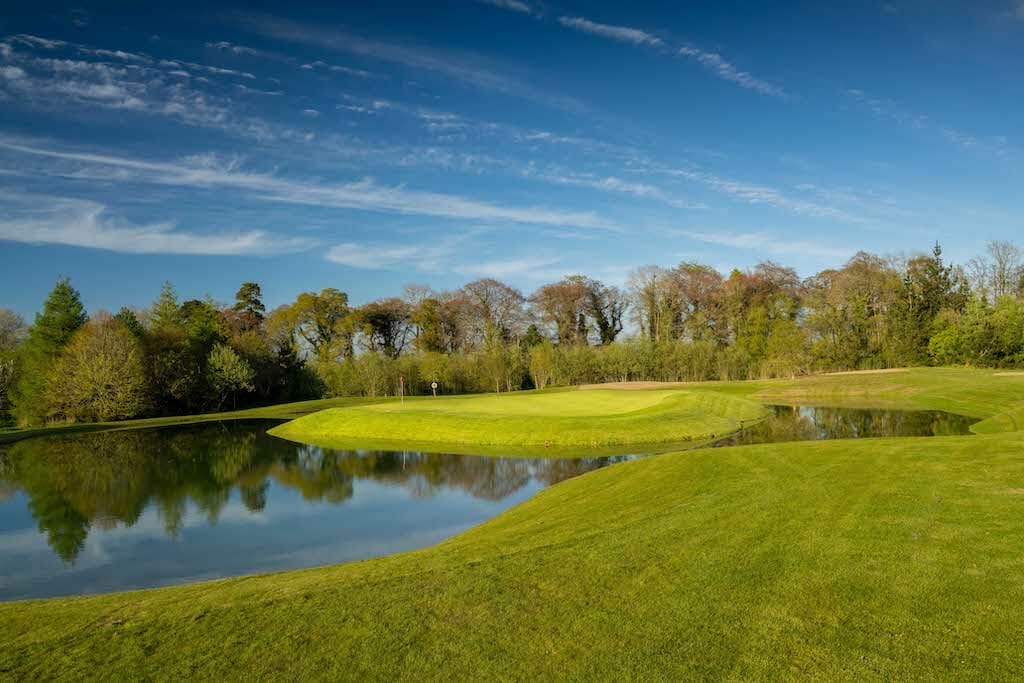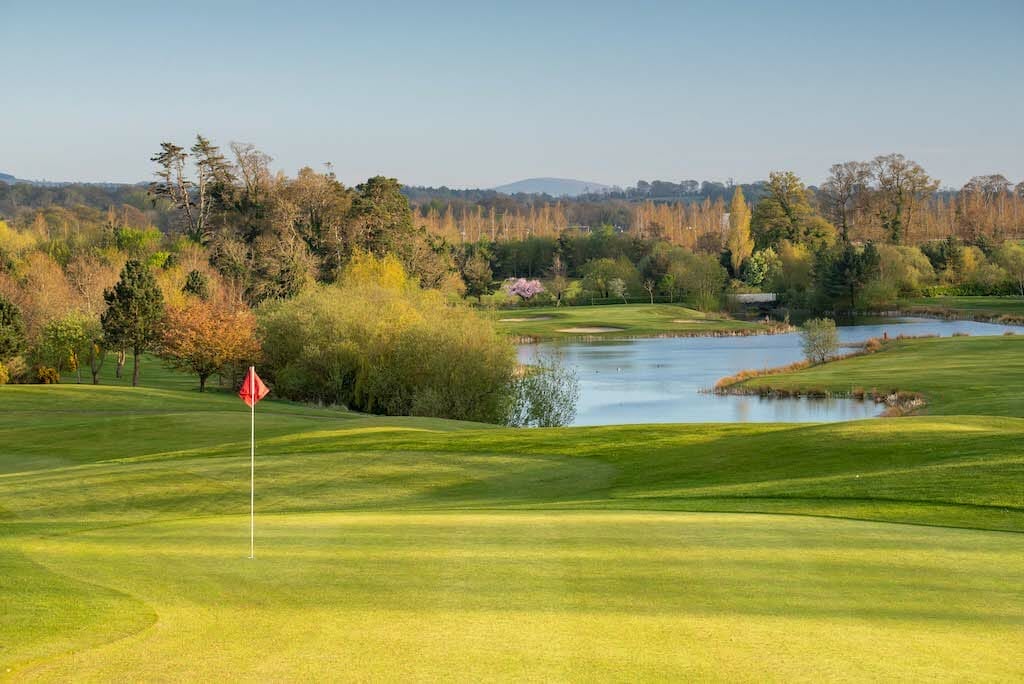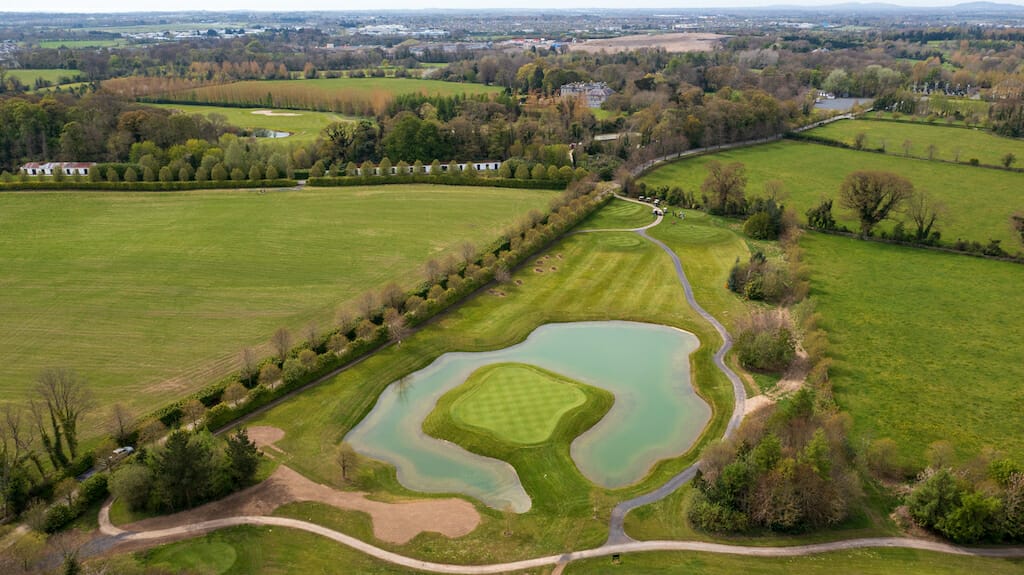After months of being away, we’re finally back on the golf course. Life has, to some degree, found a more familiar shape… even if our swings have not.
During the downtime, golf clubs around the country were busy and now members (and everybody else for that matter) are reaping the rewards of those efforts. It’s all very well being kept up-to-date about club developments through emails, newsletters and social media channels, but there’s nothing quite like seeing it and experiencing it for yourself.
After all, how could a photograph or video really show you what awaits at Palmerstown House Estate’s new 10th hole? Even as a photographer I can tell you that’s simply not possible. The spectacle is too big, and too broad to cram into a single frame.
Yes, the famous par-3 10th that was once embraced/swarmed/surrounded – take your pick – by an ocean of sand has been reimagined as an island green of a different hue. Instead of sand surrounding the putting surface, it’s now water. It is a dramatic change and one which will terrify golfers.
There’s no Get-Out-Of-Jail here: if you miss the putting surface, the slopes off the sides are so steep, so immediate, that your ball disappears faster than your playing partners can shout ‘reload’. From the middle tees it measures 150 or so yards and with the tee boxes slightly above the level of the green, it promises a fabulous shot. Hand me my 8-iron… and that old Pinnacle. It is one of the more high-profile changes being introduced this year on Ireland’s golf courses and it certainly makes a statement from a course that doesn’t always get mentioned in conversations about our best parklands.
This might seem an unfair question, given the focus of the article, but what do you consider to be the top five parklands in Ireland?
Even if you haven’t played Adare Manor, it’s probably at the top of the list, along with Mount Juliet, K Club and Druids Glen. That leaves a fifth and your selection may depend on where you live: Fota Island, Cork or Killarney if you’re from the south west; Slieve Russell or Concra Wood if you’re heading north; Carlow, if you favour the classics; and Belvoir Park, Malone or Lough Erne if you’re across the Border. But what about Dublin and the Pale? There are rich pickings here, too, including Killeen Castle, Headfort New, Luttrellstown Castle, and Carton House.
So, what are your five… and where does Palmerstown House Estate fit into the mix? I mean, look at the course’s pedigree. It was opened in 2006 after design work by Jack Nicklaus and then Christy O’Connor Junior. It is Christy’s name that hangs in the design column today, but the fact that Nicklaus was involved at all reflects the grandeur and ambition of the development.
And grandeur and ambition aptly sum up the course (and the entire 800 acre estate). Those two words have always applied here but the difficult days of 2008 and beyond saw a lot of new courses struggle to establish themselves in the limelight. Palmerstown House Estate was not alone. It is safe to say that the course is now back to its best and the clubhouse has expanded its facilities and its offering. There is more ambition here, too (see below).
The Golf Course
I first played here in 2007, and the driveway alone tells you that you are going to be met by something big. The ancient trees that calmly stretch across the landscape give it an instant air of maturity and while the course itself has changed little (excluding the new 10th) there were certain things that stuck out then that still apply today.
Let’s start with the par-5s. As a collective, the four longest holes at Palmerstown House Estate form an incredibly strong unit… and possibly the most enthralling and daunting set of par fives of any parkland in the country. Each involves playing around or over water and each offers options on how they can be played. Bear in mind that between them they have 40 or so bunkers and you’ll appreciate that the 6th, 9th, 14th and 16th are navigational nightmares.
Here’s another interesting fact: in 2007, these four holes were rated as the four hardest on the course. Today, they are indices 13, 15, 14 and 12, but three of those holes are longer than they were in 2007. Even with the less daunting indices, the optimal advice when playing these holes is to take your time.
Choosing your favourite par-5 (the 9th for me, although the 6th comes close) is as tough as choosing your favourite par-3... because the shortest holes are every bit as impressive as the longest.
Much of that has to do with the setting. The 3rd and 12th have that isolated, cocooned feel: the 3rd is nestled in an enchanting corridor of woodland and it’s all on show as you cross the bridge over the pond; and the 12th is similarly enclosed, only with the addition of old walls. Both are such sweet shots… assuming you play from the correct tee (more on that below). The 12th measures between 129 and 182 yards… and those are two very different shots.
Water is in play on three of the short holes and very much a threat. We could discuss the ‘island’ green on the 10th all day long but the 8th – the longest par-3 (178 yards from the forward tees) – and the 3rd, give you plenty to think about. I’ll add hastily that the 3rd and 8th have generous bail-out areas. The 10th does not.
The overall surroundings are colourful and comforting, especially on the front nine where that ‘estate’ feel roars through the course. The lakes and trees are a constant backdrop while the folly above the 7th green and the imposing Palmerstown House (a stunning 20 bedroom mansion which dates back to 1872, and can be rented for corporate events or privately) to the left of the 9th green add considerable flourish. The 13th, 14th and 16th holes have a more open feel but the rhythm remains the same.
Fairways are generous and you can drive freely (your tee choice is important – again, see below) as the ever-present trees rarely overshadow your progress. For me, the key to Palmerstown House is the greens. They have strong shapes, both in their outline and their slopes, and the fronts are well defended by bunkers as well as a front apron that runs up the green and will, inevitably, leave you with an uphill putt if you play too safe. In that regard you are encouraged to be more aggressive and aim pin high. The 7th green is a law unto itself: Christy O’Connor singled it out as the course’s ‘fun’ green and as brilliant as I think it is, I also find it too out of sync with the other 17.
Forewarned is Forearmed
Finally, there are a number of essential suggestions you should bear in mind when playing here and you’ll do well to pay attention.
- Choose the correct tee. There are five and the differences between them are significant. Given that the course is relatively level, it is not always easy to gauge the dangers that lie ahead (bunkers and water most notably). Being smart will ensure you don’t sink into a cauldron of cursing your luck as you take one body blow after another. The Black back tees measure 7,508 yards (only two par-4s measure less than 420 yards), the Blues are 7,043, the Whites still carry a hefty 6,814 yards while the forward ‘Green’ tees weight in at 6,558 yards. The Red tees are 5,610 yards.
As colourful, as beautiful and as level as this course is, I still want to enjoy my round by hitting approaches with 7-irons and the like, and not groaning at the thought of hitting another 3-iron. The Green tees therefore make things much more manageable… but they can also bring more trouble into play (holes 3, 6, 13, 16) if you drive a respectable distance. You have a decision to make: choose wisely.
2. Let’s talk about water. Water will significantly influence your play on 11 holes. I’d say it is highly unlikely that you’ll manage to avoid the water for 18 holes and if you favour a draw then your chances of getting wet just went up a notch. On the plus side, there are lots of swans and ducks and herons to ease the pain of the inevitable lost ball… and the ponds and lakes are oh-so-pretty.
3. One of the most typically voiced concerns are the long walks from green to tee. It’s not something you can dispute but you can counter it by saying that the terrain does not have any steep elevation changes and that it is a relaxing walk. You could also point out that apart from the 4th and 5th the risk of hearing ‘Fore’ is zero. Space has its advantages.
4. A final thought, seeing as the new 10th island green is set to make quite a splash in golfing circles: Palmerstown House already has an island green which tends to go unnoticed. The Index 1 par-4 4th green sits on an island with only the 5th tee and a sprinkling of woodland for company. So, here’s a golf course with two island greens… and there can’t be many courses in the world that can boast that.
A few words from the world of social media:
“Played it last year pre-lake, it’s one of the best parkland courses I’ve played, really tough par-5s and really challenging par-3s. Love the index 1, demands an accurate long iron for approach. Have played at all times of the season and it does get very wet unfortunately. Top track @figoflynn79
“Probably 5/6 years ago when I played it last. Always enjoyed the course, some phenomenal golf holes there – especially on that closing stretch, well pretty much from 11 onwards but with 10 looking so cool after the redesign that’s the whole back 9 sorted! @TomKGolf
“Last played it about 6 years ago. A long course with some long trips between greens and tees. Great test of golf and loved the 10th before the lake so I guess it’s a whole lot better now. @rayscott353
“Played it around 2 years ago, was blown away by it, great condition and thought lay out was fantastic. @BlaaBoi
“Mid handicapper’s opinion… Played it almost every year since it opened, plays long, rough is punishing when wet, excessive distances between green and next tee, greens usually great, great improvements in drainage recently, 15, 16 and 17 are brilliant holes. @PeterGorey
“I’ve been a member since 2013, it’s a magnificent property. Long yes but there are five sets of tees so something to suit all. The owners have invested heavily in drainage and conditioning. Brilliant team running golf operations. Future is bright as it’s one of the best parklands @NiallGorey
“Great course when played off the proper tees. Real challenge with some spectacular holes. Only downside is bunkers are generally awful @gdunning10
“Crackin’ course. Great variety of holes, and a proper test of golf. @Tony_Corcoran
Ambition and Investment Ongoing
The new signature 10th green is not the only thing Palmerstown House Estate is changing. A new fleet of machines has been purchased including a rough mower, greens mower, green roller, bunker rake, and verti-drainer. This will clearly enhance the presentation and condition of the course.
The main bar will be completely renovated and will be available once hospitality is allowed re-open. This will include a designated members–only area and will enable the club to provide a better service for everyone.
The driving range is undergoing a full renovation. Located next to the car park/clubhouse changes will include twelve covered bays, eight outdoor bays and two teaching bays. The existing grass hitting area will be improved and will be available during the summer months. The landing area will see major drainage works while new target greens will be built to help golfers during warm-up and practice. Floodlights are also being installed so the range will be available throughout the year.
The goal is to provide a top class practice facility which will be available all year round. The range won’t be open until after the summer as these works are ongoing.



























Leave a comment